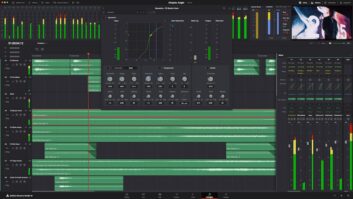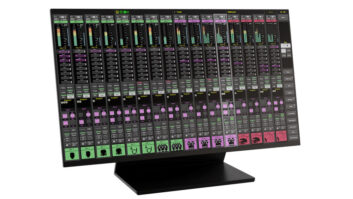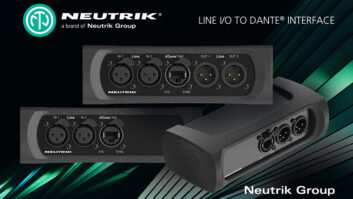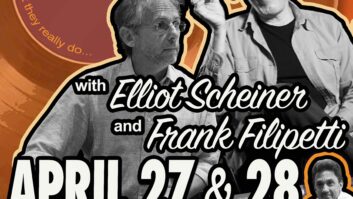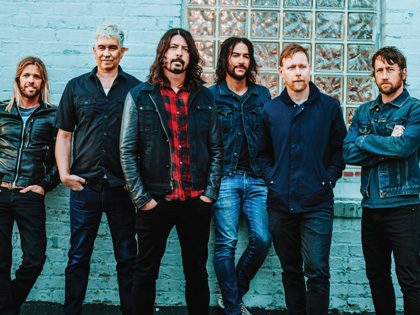
When it came time to record the Foo Fighters’ new album, Concrete and Gold, frontman Dave Grohl knew he wanted to do something different—again. The band’s previous album, Sonic Highways, featured songs written and recorded in legendary studios across the country, and had its own HBO series to accompany it. Then the Foos surprised fans with the sudden release of their St. Cecilia EP. So what could they do next that would challenge the band and excite the audience?
Grohl found the answer by joining forces with pop producer Greg Kurstin, who also happens to be half of the musical duo The Bird & The Bee, and Grohl is a huge fan. “So I think, maybe Greg is the guy that we ask to be our producer because he’s never made a heavy rock record before and we’ve never worked with a pop producer,” says Grohl; the idea was to combine “our noise and Greg’s big brain and all of his sophisticated arrangements and composition.”
“Dave asked if I’d be into working on this album with them and I was really excited,” adds Kurstin. “Especially when we talked about how much they wanted to push the sound and go nuts.”
Kurstin, the multiple Grammy-winning producer of chart-toppers such as Adele’s “Hello,” Sia’s “Chandelier” and Kelly Clarkson’s “Stronger,” brought the band into Hollywood’s EastWest Studios, which was an obvious choice for Kurstin: “We had an idea of setting up a bunch of different kinds of drum kits all miked up—some big and open and some tight,” he says. “We needed the right-size room [Studio 1] and I’d always had a great experience at EastWest. There’s great history there; Pet Sounds was recorded in Studio 3, as well as all of the great Wrecking Crew sessions that happened in that building.”
EastWest’s Studio 1 boasts an 80-channel Neve 8078 console that was originally commissioned for Michael Jackson’s Thriller. To complement this historic board, Kurstin and engineer Darrel Thorp brought in some of their favorite effects. “Darrel brought in the SPL Kuwltube and Overstayer NT-02a, which sounded great on drums,” says Kurstin. “I was focused on freaking out the sounds, so I brought the Roland RE-201 space echo, Mu- tron Bi-phase, and an A/DA flanger, which were used a lot. They also have this great ’60s fuzz/wah—kind of like a Shin-ei but sounds different. I’m not sure what the make is, but it’s gnarly.”
LENNON MEETS LEMMY
Those effects help make a noticeable difference in the Foos’ approach throughout the making of Concrete and Gold, giving the songs a more lush and layered sound than their previous albums, and helping them to achieve Grohl’s stated goal of creating “Motorhead’s version of Sgt. Pepper…or something like that.”
In fact, the tunes on Concrete and Gold evoke many musical influences. “I think it’s a combination of so many things,” says Kurstin. “There’s a lot of layered vocal parts, which reminds me of Pet Sounds or [The Zombies’] Odessey and Oracle. I’m always a sucker for how live instruments were manipulated on ’70s Berlin albums such as Iggy Pop’s The Idiot. There are so many other influences here and there, but not always intentional—we were definitely drawing from the albums we grew up listening to.”
For Kurstin, a big difference between working with a rock band and producing pop vocalists is that he could take a break from building the tracks himself. “Working with a band like the Foo Fighters, they are completely self- sufficient,” he says. “They play great with each other, so I’m searching for other ways to help with the arrangement or the overall sound. I’m able to just listen as they’re playing, which brings a whole different perspective.”
The band dynamic played a big part in how Kurstin and Thorp recorded the tracks. “I think the overall sound comes from the band’s big and raw guitar/drum sound,” says Kurstin. “On some songs, there’re distant mics on the amps to get the room. Darrel did that on the song ‘Concrete and Gold,’ and I wanted it on almost everything after that.
“Taylor [Hawkins, drummer]’s playing is really powerful and we wanted to make sure we always had the right kit and snare. The drum miking is more on the minimal side. I was doing my best to freak out sounds with pedals or using the EastWest chamber on vocals and guitars. Darrel’s way of mixing everything together sounds massive. All together we landed on this particular sound.”
Another track, “La Dee Da,” features a particularly deep sound, with multiple vocal tracks, distortion, and echo. “We started that track with Dave and Taylor playing in the room together,” says Kurstin. “We wanted to get the guitars and bass really fuzzed, so we used various guitar pedals and would overdrive the mic pre to get it as buzzy as possible. Space echo did all of the tape feedback sounds.”
SUNG FOO
Kurstin’s impact can really be heard on Grohl’s vocals. “A lot of the time we would use a Neumann U47 for Dave and sometimes blend in a cheap little mic that came with this early ’70s reel-to-reel tape recorder,” explains Kurstin. “Anything you hear that is reverby is from the chamber at EastWest. Darrel had slap echo going on some things. On ‘The Sky Is a Neighborhood,’ recorded in Studio 2, we first attempted the Bowie ‘Heroes’ multiple-gated-mic technique, but ended up liking the sound of the roomy, far away mic, so that’s what you hear on that one.” The song “Dirty Water” introduces even more new dimensions to a Foo tune, including female backing vocals and a synthesizer track. “Inara George, from my band The Bird & the Bee, does a lot of the backing harmonies on this one, along with layers of Dave,” says Kurstin. “I love working out vocal arrangements, and Dave’s guitar chords are so great, so there were a lot of possibilities for counter melodies and harmonies.
“The beginning of that track is Dave playing guitar into an iPhone in the EastWest parking lot,”says Kurstin. “At the end of the song, there’s the Gary Numan-ish Minimoog synth doubling the guitars. The two parts play off each other. We loved how the song gets so much louder when it kicks in at the end, and made sure to keep that in mastering.”
Concrete and Gold is a perfect example of music pros merging their skills to create something neither could do alone. It required an open mind from all parties, and a trust in their talents and practices.
“I think it’s most important to keep listening,” says Kurstin. “I don’t want to label what the song is going to be or sound like too early in the process. Keeping an open mind and letting things unfold is more exciting. I’m always surprised. Nothing ends up exactly the way I imagined, and I love that.”



